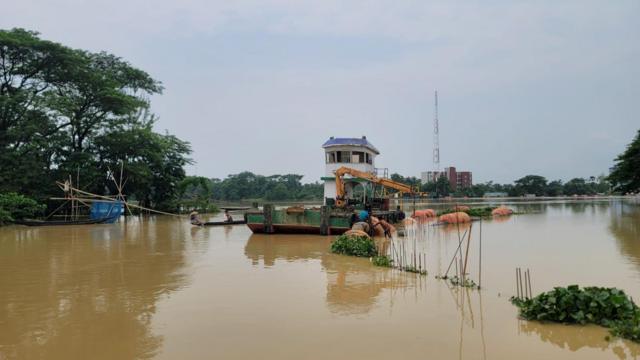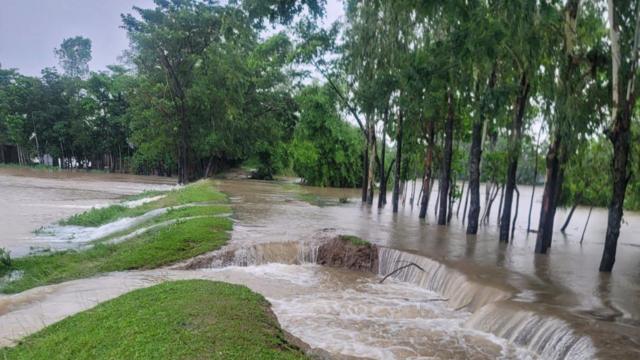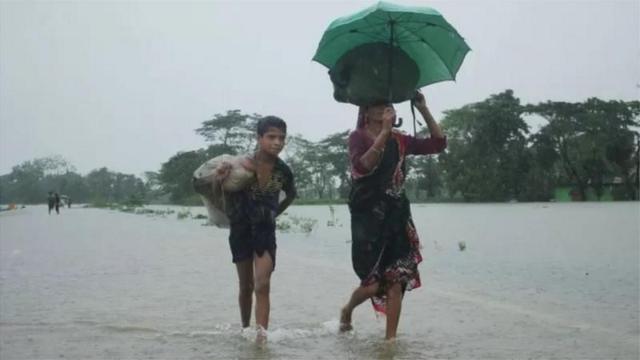The Water Development Board is predicting that it may take a week to completely clear the flash flood situation that has occurred in the Sylhet district of Bangladesh.
Sudden flood situation has arisen in seven upazilas of Sylhet district due to continuous rains and landslides from upstream for the past few days.
The Water Development Board said that the amount of rainfall is gradually decreasing and new hill slopes are not coming. If there is no abnormal rainfall again, then the flood-affected areas of Sylhet will continue to recede.
“If the rainfall continues for three more days, it is expected that Sylhet’s water level will go down in the low-lying areas in the next seven to 10 days,” said Deepak Ranjan Das, executive engineer of the Sylhet district of the Water Development Board.
Mr. Dash told the BBC that the main cause of this flood was the continuous rain in Cherrapunji. However, the rainfall rate of Sylhet and Cherrapunji in India has been decreasing for the last three days.
The Sylhet district administration says that hundreds of thousands of displaced people have taken shelter in shelters due to flash floods.
Deputy Commissioner Sheikh Russel Hasan told the BBC that at the beginning of the flood, about 5,000 people took shelter in shelters. But now they are slowly returning home.
However, there are currently 3,342 people in total 550 shelters in the district.
According to the district administration, around 600,000 people have been affected by this flood.

IMAGE SOURCE,DEEPAK RANJAN DAS
‘The situation in Sylhet is good now’
On the night of May 29, the upazilas bordering Sylhet were flooded. However, since the morning of 30th May, the water level of the rivers has started decreasing due to decrease in rainfall.
According to the latest data from Paubo, at present the water at Kanighat and Sylhet stations of Surma river and Amalshid and Sheula stations of Kushiara river is crossing the danger level.
In this regard, Deputy Commissioner Sheikh Russell Hasan said, “If there is no rain, it will also go away quickly. At the beginning of the flood, every point of the river crossed the danger mark.”
“Now the water in most of the points has come down below the danger level. Only the four points where water is coming out from Surmao Kushiara are flowing above the danger level.”
“But that’s not much either. One-two inches or half an inch,” he added.
Sylhet’s local journalist Manzoor Ahmed spoke to BBC about the flood situation. He also said that it is not raining in Sylhet now. The sun is shining in the sky there now.
“It did not rain in Sylhet yesterday. It has rained lightly today. All in all, the water is slowly coming down. And since it is not raining there (in Cherrapunji), there is no chance of another landslide and the situation deteriorating now,” he said.
Azhar Uddin Shimul, another journalist from Sylhet district, also told the BBC that the floodwaters had started receding. “The sky is sunny, there is no rain. The water in the roads is receding, people are returning home.”
However, dry food, cooked food and clean water are being provided to the Banvasi people who are yet to return home, or who have been affected by the floods.
The seven upazilas of Sylhet affected by floods are Jaintapur, Goainghat, Kanaighat, Bianibazar, Jokiganj, Sylhet Sadar and Fenchuganj. Although the flood situation in some areas of these upazilas has improved, the water has not completely receded yet.
Mr. Saturday at 11 o’clock. Dash said, “The water in Sylhet Sadar is also seven centimeters above the danger level. In areas that are more inundated, it’s more so.”

IMAGE SOURCE,GETTY IMAGES
What is the reason for so much rain?
The Water Development Board, Meteorological Office, District Administration and locals, like other times, are all saying that this flash flood is caused by hill slides due to abnormal rains.
Basically, it started raining in Sylhet from last week Monday i.e. 27th May and continued till Thursday i.e. 30th May. Cyclone Rimal hit in the last week of May.
According to the Meteorological Department, only Sylhet district received 775 mm rainfall and 707 mm rainfall in Moulvibazar district in May this year.
Also, Cherrapunji in the Indian state of Meghalaya also received record rainfall. In the last 24 hours, there has been 54 mm of rain. Cherrapunji received 193 mm of rain in the previous 24 hours and 643 mm in the previous 24 hours.
Also, monsoon has set in earlier this year in Northeast than other years.
It usually takes the first week of June, sometimes the second week, for the monsoon to set.
Meteorologist Md. Omar Farooq said, because of Cyclone Rimal, the water vapor in the air was already high. Also the monsoon has set in. Due to this, the amount of water vapor has increased there.”
“Precipitation has increased due to higher water vapor content in the air. If the transition from pre-monsoon to monsoon comes earlier, such incidents are more likely,” he added.
Due to their geographical location, Sylhet in Bangladesh and Meghalaya in India, these two areas usually receive more rainfall than other places.
Mr. Farooq explains, “Water vapor from the Bay of Bengal gets trapped there. Then it ascended and formed thunderclouds and heavy rain fell in the region.”
Temperatures in most parts of Bangladesh are now below 36 degrees Celsius. “But still everyone feels a bit hot. This is because the presence of water vapor is very high.”
According to the information provided by the Meteorological Office, Sylhet received a total of 329 mm of rain in May last year. It was 184 millimeters in Moulvibazar.
And, in May 2022, Sylhet district received 837 mm of rain. Only Srimangal received 625 mm. Cherrapunji received 1000 mm of rain that year.

IMAGE SOURCE,DEEPAK RANJAN DAS
This Sylhet flood is unusual?
Usually Sylhet experiences three to four minor floods in a year in the months of May, June and August.
But Sylhet has never experienced such a flood at the end of May. Paubo’s executive engineer Mr. Dash said, “What has happened in 2022 and this time of year is record breaking. This has never happened.”
He has termed this sudden flood as ‘Early Flood’.
He thinks that the terrible flood situation that occurred in Sylhet in 2022, the severity of this flood is no less than the previous one.
Because, “The place where we measure the water level of Surma river is Kanighat. The water level there in 2022 was 17.15 cm. This time the maximum is 17.57 cm. That is, 42 cm above the 2022 flood,” he explained.
“If you think about the water level, there is definitely more water this year than in 2022.”
It is to be noted that the flood that occurred in the Sylhet-Sunamganj region in the middle of June 2022 affected about 3 million people in those two districts.

IMAGE SOURCE,GETTY IMAGES
Causes of frequent floods in Sylhet
Researchers are looking at several other reasons behind the floods that occur almost every year in the northeastern districts of Bangladesh including Sylhet, Sunamganj and Kurigram.
River researchers believe that heavy rains in India’s Assam and Meghalaya are a major factor behind the flash floods, but some other factors have also played a role.
One of them is the loss of water carrying capacity of the river. Due to the loss of navigability of the rivers in that region, excess rainwater from Meghalaya or Assam cannot flow out of Haor through Meghna or Yamuna to the Bay of Bengal.
Also, the unplanned development of Haor area including Sylhet is also responsible for this.
In 2022, the director of Bangladesh University of Engineering and Water Management Institute, AKM Saiful Islam, told the BBC, “In Sylhet or Sunamganj area, the land was like that before, the river was navigable, there were not so many roads or structures were built.”
“As a result, the flood water now takes time to recede. Earlier, because there were swamps and sinkholes, flood water could stay in many places. But now that is not happening.”
He also said, “We have made roads in various places in Howar. As a result, the water flow is obstructed. Due to the construction of houses in urban areas, water is no longer getting a chance to go to the ground. As a result, we are experiencing more intensity of flood. These are causing early flooding and very severe flooding.”